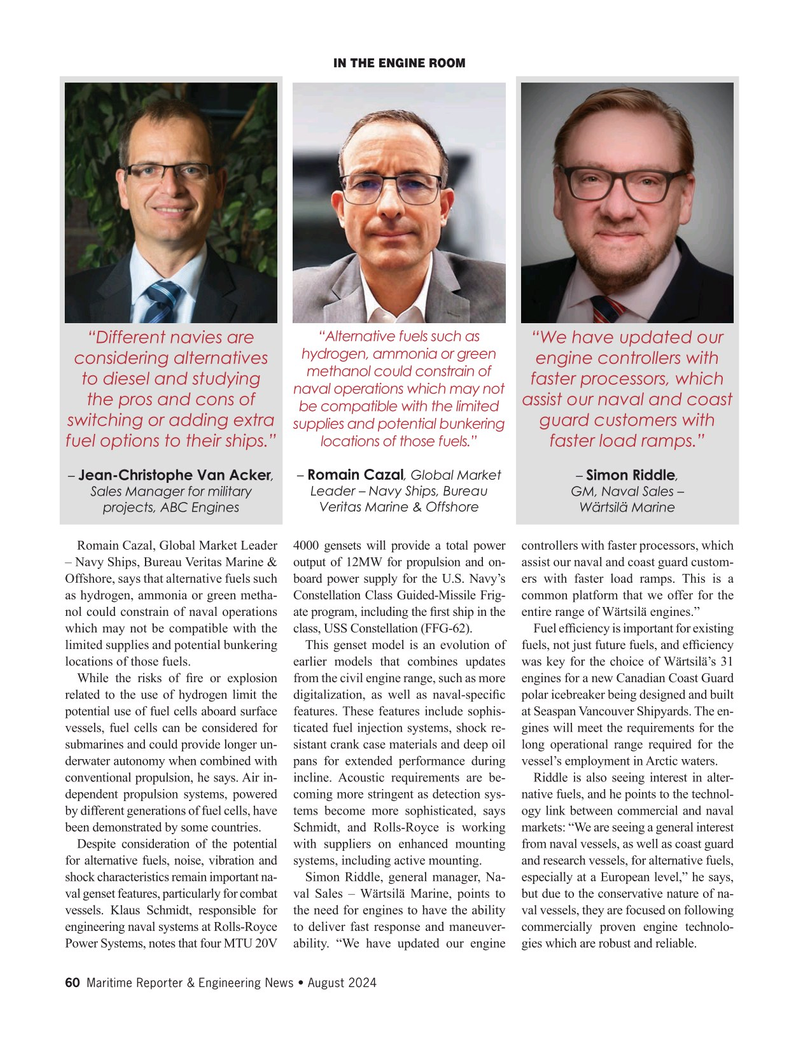
Page 60: of Maritime Reporter Magazine (August 2024)
Read this page in Pdf, Flash or Html5 edition of August 2024 Maritime Reporter Magazine
IN THE ENGINE ROOM “Alternative fuels such as “Different navies are “We have updated our hydrogen, ammonia or green considering alternatives engine controllers with methanol could constrain of to diesel and studying faster processors, which naval operations which may not the pros and cons of assist our naval and coast be compatible with the limited switching or adding extra guard customers with supplies and potential bunkering locations of those fuels.” fuel options to their ships.” faster load ramps.”
Romain Cazal Jean-Christophe Van Acker Simon Riddle , Global Market – – , – ,
Leader – Navy Ships, Bureau Sales Manager for military GM, Naval Sales –
Veritas Marine & Offshore projects, ABC Engines Wärtsilä Marine
Romain Cazal, Global Market Leader 4000 gensets will provide a total power controllers with faster processors, which – Navy Ships, Bureau Veritas Marine & output of 12MW for propulsion and on- assist our naval and coast guard custom-
Offshore, says that alternative fuels such board power supply for the U.S. Navy’s ers with faster load ramps. This is a as hydrogen, ammonia or green metha- Constellation Class Guided-Missile Frig- common platform that we offer for the nol could constrain of naval operations ate program, including the ? rst ship in the entire range of Wärtsilä engines.” which may not be compatible with the class, USS Constellation (FFG-62). Fuel ef? ciency is important for existing limited supplies and potential bunkering This genset model is an evolution of fuels, not just future fuels, and ef? ciency locations of those fuels. earlier models that combines updates was key for the choice of Wärtsilä’s 31
While the risks of ? re or explosion from the civil engine range, such as more engines for a new Canadian Coast Guard related to the use of hydrogen limit the digitalization, as well as naval-speci? c polar icebreaker being designed and built potential use of fuel cells aboard surface features. These features include sophis- at Seaspan Vancouver Shipyards. The en- vessels, fuel cells can be considered for ticated fuel injection systems, shock re- gines will meet the requirements for the submarines and could provide longer un- sistant crank case materials and deep oil long operational range required for the derwater autonomy when combined with pans for extended performance during vessel’s employment in Arctic waters.
conventional propulsion, he says. Air in- incline. Acoustic requirements are be- Riddle is also seeing interest in alter- dependent propulsion systems, powered coming more stringent as detection sys- native fuels, and he points to the technol- by different generations of fuel cells, have tems become more sophisticated, says ogy link between commercial and naval been demonstrated by some countries. Schmidt, and Rolls-Royce is working markets: “We are seeing a general interest
Despite consideration of the potential with suppliers on enhanced mounting from naval vessels, as well as coast guard for alternative fuels, noise, vibration and systems, including active mounting. and research vessels, for alternative fuels, shock characteristics remain important na- Simon Riddle, general manager, Na- especially at a European level,” he says, val genset features, particularly for combat val Sales – Wärtsilä Marine, points to but due to the conservative nature of na- vessels. Klaus Schmidt, responsible for the need for engines to have the ability val vessels, they are focused on following engineering naval systems at Rolls-Royce to deliver fast response and maneuver- commercially proven engine technolo-
Power Systems, notes that four MTU 20V ability. “We have updated our engine gies which are robust and reliable.
60 Maritime Reporter & Engineering News • August 2024
MR #8 (50-65).indd 60 8/8/2024 4:12:14 PM

 59
59

 61
61
